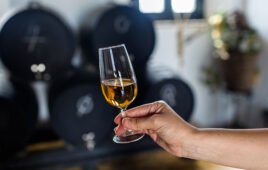
“Pouring for the Culture,” presented by Kelly Smith Killian, Chief Content Officer at Wright Creative, and Nelson German, Executive Chef/Owner at Sobre Mesa and alaMar Kitchen & Bar
This year’s National Restaurant Association Show (NRA), May 21-24 at McCormick Place in Chicago, showcased hundreds of new products, networking opportunities, workshops, demos and education sessions, including an all-new feature: The Beverage Room.
The Beverage Room pavilion focused the top trends in drinks and mixology, including beer, wine, spirits, bar specialty equipment, cocktail ingredients and more in sessions presented by chefs, culinary leaders, mixologists and other beverage experts. Here are a few key trends to watch:
Experiences
From food and beverage pairings, tastings, flights themed nights, “millennials crave experiences,” says John Laloganes, Director of Beverage Management and Assistant Professor at Kendall College at National Louis University, in the session titled, “The New Drinking Occasions.”
This plays well into another key trend: seasonality. Each change of the season, each holiday and celebration, is an opportunity to create a memorable experience for the guest, and drinks—alcoholic or not—are an important part of these experiences. According to Laloganes, 39% of consumers ages 18-34 say their “favorite drink flavors change along with the seasons.” And 69% of millennials are more likely to buy seasonal items.

“The New Drinking Occasions,” presented by John Laloganes, Director of Beverage Management and Assistant Professor at Kendall College at National Louis University
Not only do seasonal drinks and limited-time offers for holidays, festivals and more serve as an experience for guests, they also building overall excitement and urgency—and motivate frequency of visits.
And seasonal-inspired draft wine and cocktails are a fun, on-trend wine to keep things fresh—while also promoting efficiency.
“Tap cocktails are in right now,” confirms Nelson German, Executive Chef/Owner at Sobre Mesa and alaMar Kitchen & Bar. “The age of the gin and tonic taking 20 minutes is over.”
Focus on Culture
In the session, “Pouring for the Culture,” German spoke with Kelly Smith Killian, Chief Content Officer at Wright Creative, about the the societal shifts of the past two years and the influence of culinarians’ own cultures on food and bar menus.
German’s, whose Dominican heritage is present at his Sobre Mesa—the first-known Afro-Latino bar on the West coast—says consumers are more receptive to new cultures than ever before.
“We can really be ourselves,” he says, “and our guests connect more with that experience.”

Executive Chef/Owner Nelson German demonstrates Sobre Mesa’s takes on classic drinks, like the espresso martini
Whether it’s an entirely new concept or an updated take on a classic, today’s consumers want to learn about culture through food, drink—and ingredients.
For example, the restaurant’s signature cocktail, named the Sobre Mesa, features Mosswood light rum blend, dominican rum, sobre mesa mamajuana mix, lime and grapefruit. And its Over the Table Old Fashioned pairs Jim beam double cask bourbon with falernum, mango-brown sugar syrup and bitters.
“There’s nothing wrong with taking classics and switching them around a little bit,” he says. “It’s your base.”
Zero-Proof
In the session, “The Allure of Spirit-Free Alternatives,” Michael Sabitoni of Johnson & Wales University’s College of Hospitality Management spoke with Martin Murch of Good Eats Group about the ever-growing trend toward alcohol-free beverage options.
Sales in non-alcoholic beverages rose 33.2% last year, with a total of $331 million in sales, according to NielsenIQ. Sometimes called the “sober curious movement,” millennials and Gen Z are drinking less than Gen X and Boomers did at their age. Even if they’re not cutting alcohol out completely, young consumers expect to see mocktails on the menu in additional to things like soda and juice.

“The Allure of Spirit-Free Alternatives,” presented by Michael Sabitoni of Johnson & Wales University’s College of Hospitality Management and Martin Murch of Good Eats Group
It’s important, when creating a mocktail (or a zero-proof drink, which seems to be the more modern term), to apply the same theories and care you would for a typical, alcoholic cocktail. Try using a tea as the base, and make your syrups and juices in-house whenever possible.
And keep in mind: Cross-utilization of ingredients is key to simplifying operations.
The zero-proof trends goes hand-in-hand with the better-for-you trend, which continues to gain momentum. Whether their drink is alcoholic or not, many consumers seek options that perceive as healthier or with added benefits. For example, drinks made with functional ingredients, or “nutrient drinks,” may contain things like antioxidants, vitamins and herbs.
CBD- and TBH-containing drinks are also on the rise, as are natural and organic wines.
Ultimately, a strong beverage program is an extension of your brand and of your culinary experience. Keeping up with the top trends in this space will ensure you’re attracting and retaining guests for generations to come.




